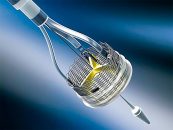The introduction of transcatheter aortic valve replacement (TAVR) into clinical practice in the United States has been a tightly controlled process aimed at optimizing patient outcomes and minimizing the learning curve. Many strategies have been used to reach a rational dispersion for this new technology, including choosing sites with enough volume, and adequate operator training…
Lotus Valve performance related to pacemaker implantation in patients after TAVR
Courtesy of Dr. Agustín Vecchia. Paravalvular leak was once considered the greatest disadvantage of TAVR when compared to conventional surgery. Nowadays, new devices and more-experienced operators have managed to “control” this phenomenon, keeping related statistics within acceptable ranges. Repositionable-valve Lotus may probably offer the most effective solution for this event; however, it is associated with high rates of…
MitraClip: Should We Intervene Earlier?
Courtesy of Dr. Carlos Fava. Repairing the mitral valve with Mitraclip has become an alternative for high risk or inoperable symptomatic patients, but its long term evolution has only been tested by the EVEREST II, which had not taken into account 5 year mortality outcomes. Therefore, to better study its evolution, we need to carry out different randomized studies…
Post-dilation in TAVI associated to more stroke and more paravalvular regurgitation
Courtesy of Dr. Carlos Fava. Moderate/severe paravalvular regurgitation (PVR) after TAVR is present in 10%-14% of all cases, according to different series. The treatment of choice is post-dilation, generally effective in most cases. However, this strategy carries a risk of stroke. The true impact of this conduct is still unclear. This review analyzed 6 studies that included 5007 patients; 889 of…
Transcatheter valve replacement in the bicuspid valve is increasingly performed, but challenges remain
As experience increases, transcatheter aortic valve replacement (TAVR) has expanded to different populations and anatomies. This study sought to compare technical and clinical outcomes in patients with bicuspid versus tricuspid aortic stenosis from the Bicuspid AS TAVR Multicenter Registry. Outcomes of 561 patients with bicuspid valves and 4546 patients with tricuspid valves were compared. Propensity score matching was used…
Incidence, characteristics, and treatment of valve thrombosis after TAVR
Certain studies have carried out a tomographic follow-up of patients who underwent transcatheter aortic valve replacement (TAVR) and described the frequency of leaflet thrombosis; however, in most cases, it is unclear whether this finding requires some sort of intervention. The difference between this work and those previously published is that this study is not focused on imaging, it…
SENTINEL study: cerebral protection during TAVR
Neurological complications during and after transcatheter aortic valve replacement (TAVR) are probably the only event whose incidence has not been reduced by new valve designs (as opposed to paravalvular leak, vascular complications, or need for pacemaker implantation). Aside from the potential seriousness of this clinical event, the risk of embolism is particularly worrisome because,…
In-hospital morbid-mortality rates for balloon aortic valvuloplasty are similar to those for transcatheter aortic valve implantation
Courtesy of Dr. Carlos Fava. The balloon aortic valvuloplasty (BAV) was introduced by Dr. Cribier in 1986. However, given its poor results, soon after it fell into disuse. With the introduction of TAVR, it saw a revival as bridge for another intervention, even though it is still resisted in many places. The present study…
[SURTAVI] Sub-study of neurological events: more evidence in favor of TAVR
Courtesy of SBHCI. The occurrence of a periprocedural neurological events is associated to an increased risk of death and morbidity at long term, both for transcatheter aortic valve replacement (TAVR) and for surgery. The SURTAVI study, recently presented at the ACC meeting and simultaneously published by NEJM, showed that TAVR with self-expandable CoreValve or Evolut…
NOTION: TAVI with low risk at 4 year follow up
Courtesy of the SBHCI. There is little data about the use of transcatheter aortic valve replacement (TAVR) to treat patients with severe aortic stenosis at low surgical risk. Many of the questions involve long term duration of valves (over 10 years) when treating younger patients with longer life expectancy. The NOTION study aims at comparing…
VIVA Post-Market Study: More Evidence for the Valve-in-Valve Technique
Courtesy of the SBHCI. Bioprosthetic surgically-implanted valves degenerate over time, while patients become too old and are at high risk for reoperation. Transcatheter aortic valve implantation inside a deteriorated surgically-implanted valve (a valve-in-valve procedure) is an emerging alternative. The VIVA trial was designed to offer systematic and prospective data from patients treated with…










